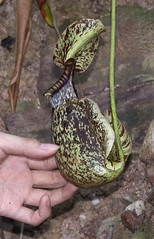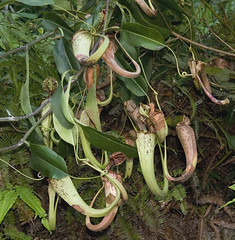The coastal forest of Sarang Rimau at Siloso has a good number of Raffles' pitcher plants, which grow as mature vines that clamber and dangle from the larger trees. They are a carnivorous plant species and should be not confused with the plants known as Rafflesia, which are also vines but parasites with no leaves but very large flowers (and are not found in Singapore).
Pitcher plants have specialised leaves that form containers with fluid that is able to digest small animals from ants to even vertebrates like rats. The pitchers are an adaptation that allows the plant to survive in poor soils and other environments where nutrients are deficient and where most other plants cannot thrive.
The pitcher even has a 'lid' on top which is thought to help provide shade against rainwater that could cause the pitcher to overflow. Like most other Nepenthes species, N. rafflesiana produces two types of pitchers: upper and lower. The lower pitchers are produced on branches closer to the ground and are goblet-like, with two 'wings' that may serve to stabilise the pitcher on the ground. They are also much more colourful, with a marbled pattern, especially on the edge of the pitcher. Upper pitchers are slim with a tapered end and are produced on the higher vine-like portions of the plant.
Many small animals meet their doom in the pitchers, but there are also a few which can survive or even make a living from the pitcher plants. Some species of mosquitoes (not the disease-causing types) breed by laying eggs in the pitchers, and the larva feed on the remains of victims in the pitcher fluid. A species of crab spider can also be found which specialises on catching insect prey that approaches the pitchers.
Subscribe to:
Post Comments (Atom)



No comments:
Post a Comment